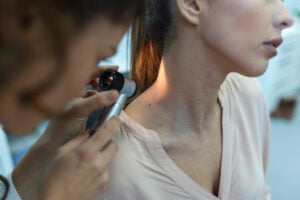Occupational skin diseases are amongst the most commonly reported work-related health issues. According to data from the HSE, an estimation of 16,000 people working within the last year are suffering from skin issues that they claim have been caused or worsened by work. Such diseases not only have the capability to end impacted employees’ careers, but are also highly problematic for employers due to sickness absence and compensation expenses.

https://www.freepik.com/photos/eczema Eczema photo created by stefamerpik – www.freepik.com
Which industries are most commonly affected by occupational skin diseases?
Work-related skin conditions can develop in almost any industry. There are, however, certain occupations deemed as high-risk for dermatological conditions:
Catering
Employees of catering businesses can face increased risk of occupational skin issues due to preparation and handling of lots of food, having to wash their hands quite often and cleaning kitchens surfaces and utensils as a part of their daily work routine. According to the HSE, the number of skin dermatitis cases in the catering industry each year is twice the average of all other industries.
Hairstyling
It is estimated that more than 70 percent of hairdressers suffer from occupational skin conditions at some point during their career. This is due to working with chemicals contained in hairdressing products like shampoo, hair dye or bleach. Having employees’ hands in contact with water for long periods of time and on a daily basis is also one of the main reasons for skin conditions in this industry.

https://www.freepik.com/photos/hair-stylist Hair stylist photo created by freepik – www.freepik.com
Motor Vehicle Repair
Employees who work for businesses which involve engine or vehicle body repairs are also among the highly endangered, with spray painters being seven times more likely to develop dermatitis than the average working population. The cause is frequent contact with engine oil, degreasing substances, fine dust during hand sanding and other substances which can cause a range of conditions.
These are only some of the most affected industries. Others include dentistry, printing, construction, and many more.
What are the work-related skin conditions that can occur?
Three main groups of occupational skin diseases exist:
Irritant contact dermatitis
Occupational irritant contact dermatitis is responsible for 80% of all work-related skin conditions and occurs due to harsh chemicals encountering the skin, damaging its surface quicker than it is able to repair itself. Symptoms may include the skin becoming inflamed, blistered, dry and thickened, and changing colour.
Allergic contact dermatitis
Allergic contact dermatitis is caused by a reaction to a specific material or substance and occurs when the allergen contacts the skin. Some of the common symptoms are itchiness, swelling and blistering of the skin and may appear similar or the same as those caused by irritant contact dermatitis.
Other skin conditions
Dermatitis is not the only skin condition that can develop as a result of occupational exposure. There are other work-related skin issues that can occur, and despite comprising less than 10 percent of the total number of cases, some of them can be very serious. They include skin cancer, infections, scleroderma, onycholysis, miliaria, and many others.
What can employers do to effectively manage and prevent occupational skin conditions?
Monitoring of occupational skin conditions is done through a process called dermatology screening. Occupational dermatology screening is a process used to indicate conditions that place workers at risk and to detect early symptoms of occupational skin diseases using regular skin examinations as a health surveillance practice.

https://www.freepik.com/photos/dermatologist Dermatologist photo created by stefamerpik – www.freepik.com
How does dermatology screening monitor work-related skin diseases?
Dermatology screening requires the employee to fill out a questionnaire that can help identify any work-related conditions that may indicate areas of concern regarding dangerous skin exposure. Regular examinations are also a part of the surveillance, focusing predominantly on the hands and arms of the employees to detect any symptoms that might be present.
Are you looking for an effective way to include skin health surveillance into your occupational health strategy? We at Healthscreen UK offer dermatology assessments at the workplace as part of the services we have available across the country! Contact us today to speak to an advisor or click here to get a quote!







